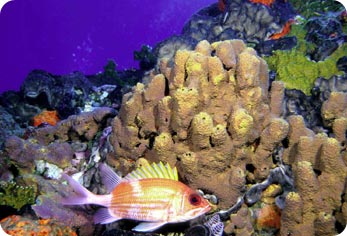Much of the floor of the Gulf of Mexico is flat and drab. But about a hundred miles off the Texas coast, it explodes with life and color. Yellow-and-blue angelfish, burnt orange creolefish, and kaleidoscopic grouper live among coral reefs that can reach to within 50 feet of the surface. Purple and orange sponges are anchored to the bottom, along with red seaweed. And fuzzy orange worms and flaming ruby brittle stars scuttle along the seabed.
 Colorful corals and fish at the Flower Gardens. Credit: National Oceanic & Atmospheric Administration
Colorful corals and fish at the Flower Gardens. Credit: National Oceanic & Atmospheric AdministrationThese colorful patches of ocean floor are known as the Flower Gardens. They’re the northernmost coral reefs in the continental United States. Since 1992, they’ve been protected as a National Marine Sanctuary.
There are two distinct gardens, a few miles apart. Each covers a few hundred acres. They sit atop salt domes, which push upward from the floor of the Gulf. In some places, the tops of these domes are as little as a hundred to a hundred fifty feet below the surface. The shallow depths provide plenty of light and warm water year round -- perfect conditions for coral reefs.
Other creatures congregate around the corals. Scientists have cataloged more than 200 species of fish in the Flower Gardens -- mainly seabass and grouper. They’ve also found turtles, shrimp, crabs, lobsters, octopuses, snails, and more than 80 species of algae -- including a bright red seaweed.
Like much of the oceans, the Flower Gardens are facing some tough environmental challenges these days. But so far, they remain some of the most colorful havens of life in the Gulf of Mexico.

